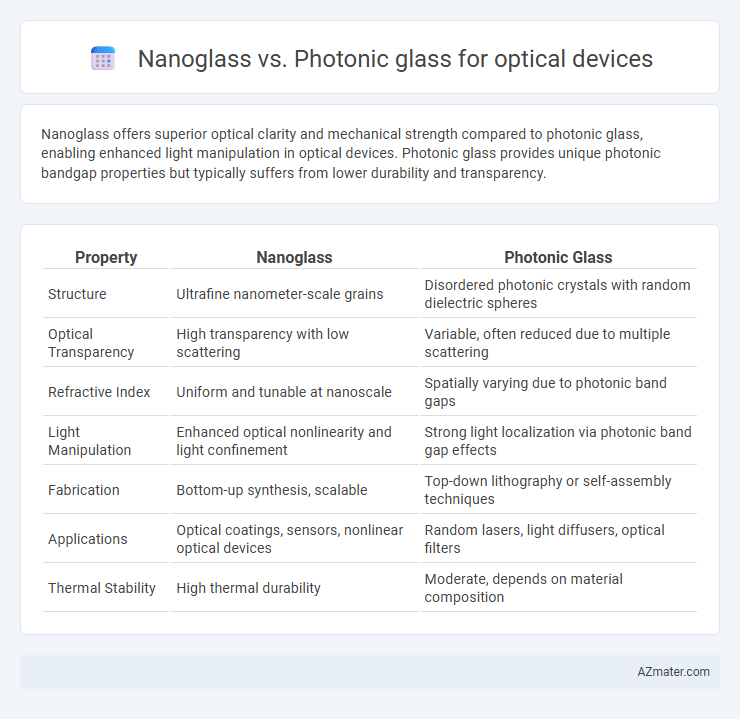Nanoglass offers superior optical clarity and mechanical strength compared to photonic glass, enabling enhanced light manipulation in optical devices. Photonic glass provides unique photonic bandgap properties but typically suffers from lower durability and transparency.
Table of Comparison
| Property | Nanoglass | Photonic Glass |
|---|---|---|
| Structure | Ultrafine nanometer-scale grains | Disordered photonic crystals with random dielectric spheres |
| Optical Transparency | High transparency with low scattering | Variable, often reduced due to multiple scattering |
| Refractive Index | Uniform and tunable at nanoscale | Spatially varying due to photonic band gaps |
| Light Manipulation | Enhanced optical nonlinearity and light confinement | Strong light localization via photonic band gap effects |
| Fabrication | Bottom-up synthesis, scalable | Top-down lithography or self-assembly techniques |
| Applications | Optical coatings, sensors, nonlinear optical devices | Random lasers, light diffusers, optical filters |
| Thermal Stability | High thermal durability | Moderate, depends on material composition |
Introduction to Nanoglass and Photonic Glass
Nanoglass and photonic glass are advanced materials crucial for optical devices due to their unique light manipulation capabilities. Nanoglass features an amorphous structure composed of uniformly sized nanoparticles, offering exceptional optical transparency and enhanced mechanical strength. Photonic glass consists of disordered arrangements of dielectric particles that create isotropic photonic band gaps, enabling precise control of light propagation for innovative optical applications.
Material Composition and Structural Differences
Nanoglass consists of ultrafine amorphous silica particles compacted to create a non-crystalline, highly transparent material with nanoscale porosity, optimizing light scattering and transmission for optical devices. Photonic glass, typically formed from randomly arranged monodisperse dielectric spheres like silica or polystyrene, leverages structural disorder to manipulate photonic band gaps and control light propagation without periodicity. The fundamental difference lies in nanoglass's amorphous nanoscale structure versus photonic glass's disordered microsphere assembly, resulting in distinct optical properties crucial for device performance.
Optical Properties: Light Transmission and Scattering
Nanoglass exhibits superior light transmission due to its ultra-smooth surface and reduced scattering centers, resulting in minimal optical losses compared to photonic glass. Photonic glass relies on engineered structural disorder to manipulate light scattering, enhancing diffuse reflection and localized light interference effects. Nanoglass's homogenous nanostructure provides clearer optical pathways, whereas photonic glass excels in applications requiring controlled scattering and wavelength-selective reflection.
Fabrication Techniques and Technological Advancements
Nanoglass for optical devices is fabricated using advanced sol-gel and atomic layer deposition techniques, enabling precise nanoscale control and uniform thin films that enhance optical properties such as transparency and refractive index tunability. Photonic glass fabrication commonly employs colloidal self-assembly and direct laser writing, facilitating complex three-dimensional photonic structures with tailored bandgaps for light manipulation and minimal scattering losses. Recent technological advancements in nanoglass involve integrating dopants at the atomic level for active optical functionalities, while photonic glass benefits from innovations in multi-photon lithography that boost fabrication resolution and scalability for complex integrated photonic circuits.
Performance in Optical Devices: A Comparative Overview
Nanoglass exhibits superior optical clarity and reduced scattering due to its ultra-fine nanoscale structure, enhancing light transmission and minimizing signal loss in optical devices. Photonic glass, with its engineered disorder and tailored refractive index variations, provides exceptional control over light diffusion and photonic bandgap effects, enabling efficient manipulation of light paths. Both materials offer distinct advantages--nanoglass excels in transparency and low attenuation, while photonic glass enhances light management through structural design--making their selection dependent on specific device performance requirements.
Applications in Photonics and Optoelectronics
Nanoglass exhibits superior optical transparency and enhanced mechanical strength, making it ideal for high-performance photonic devices such as waveguides and optical sensors. Photonic glass, characterized by its disordered nanostructure, enables unique light manipulation capabilities used in photonic crystals, optical filters, and random lasers for advanced optoelectronic systems. Applications in photonics and optoelectronics leverage nanoglass for stability and efficiency, while photonic glass excels in tailoring light propagation and scattering for novel device functionalities.
Durability, Stability, and Environmental Resistance
Nanoglass exhibits superior durability compared to photonic glass due to its dense atomic structure, enhancing resistance to physical wear and mechanical stress in optical devices. Photonic glass offers excellent environmental stability with inherent resistance to temperature fluctuations and humidity, maintaining consistent optical performance over time. Both materials demonstrate high chemical stability, but nanoglass provides enhanced protection against corrosive environments, making it more resilient for long-term outdoor applications.
Integration with Modern Optical Systems
Nanoglass offers superior nanoscale uniformity and low optical losses, enabling seamless integration with silicon photonics and other modern optical platforms. Photonic glass provides customizable photonic bandgap properties, facilitating tailored light manipulation within integrated optical circuits. Both materials support advancements in compact, high-performance optical devices essential for next-generation communication and sensing technologies.
Cost-Effectiveness and Scalability for Industry
Nanoglass offers superior cost-effectiveness due to its lower material consumption and simplified fabrication process compared to photonic glass, reducing production expenses significantly. Photonic glass, while providing excellent optical properties, often involves complex nano-patterning techniques that limit scalability and increase manufacturing costs. Industry adoption favors nanoglass for mass production as it enables scalable fabrication with consistent performance, essential for widespread optical device applications.
Future Prospects and Emerging Trends in Optical Materials
Nanoglass materials exhibit exceptional tunability in refractive indices and enhanced transparency, making them promising for next-generation optical devices with improved efficiency and miniaturization. Photonic glass offers unique advantages in controlling light propagation through disordered structures, enabling innovative applications in optical sensing, communication, and light management. Emerging trends emphasize hybrid nanoglass-photonic glass composites to optimize optical properties, enhance device performance, and enable scalable fabrication techniques for advanced photonic technologies.

Infographic: Nanoglass vs Photonic glass for Optical device
 azmater.com
azmater.com